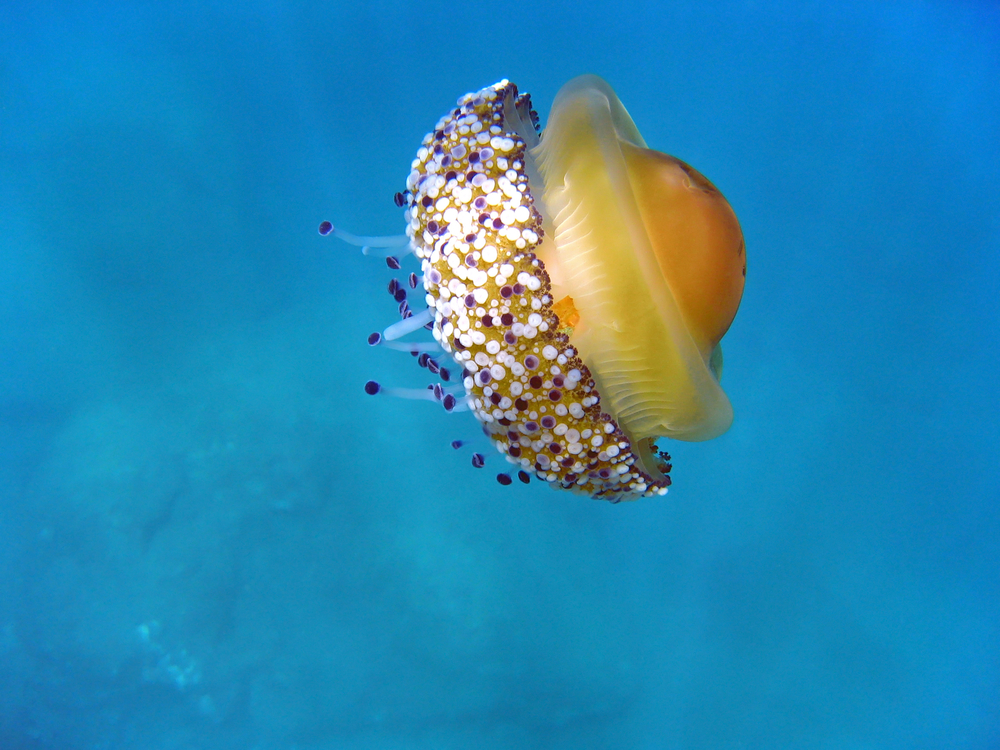
Jellyfish are found in every ocean, from the surface to the ocean floor. Despite having no head, heart, brain, bones, cartilage or real eyes, they are still major predators. Their stinging cells are amongst the most complicated cells in the animal kingdom, and many have stings that can cause us serious harm. Yet they are also some of the Earth’s most beautiful creatures. Welcome to the weird and wonderful world of jellyfish.
Moon Jellyfish

The moon jellyfish is translucent, with colouration in patterns of spots and streaks and a fringe of thin tentacles. It is found in the Atlantic, Pacific and Indian Oceans in mostly warm and tropical waters near the coast. It collects food by gathering medusae, plankton and molluscs with its tentacles and bringing them into its body for digestion. This particular jellyfish also has astounding powers of transformation and regeneration. One scientists observed polyp emerge from a moon jellyfish that had been dead for three months. Instead of dying, the polyp morphed into a younger polyp stage—it appears that this jellyfish can age backwards.
Flower Hat Jellyfish

This is a rare jellyfish with a lifespan of just four to five months, found in coastal waters of the western Pacific Ocean off the coast of southern Japan. Its multi-coloured tentacles trail can be quickly coiled and uncoiled from the rim of its translucent pinstriped bell. It prefers to spend time on the sea floor, where it scoops up small fish and marine invertebrates to eat. The sting of an individual is painful, leaving a bright rash, but it is when they are in groups called blooms that they cause the real problems. Blooms have been spotted in Brazil and Argentina (where they are thought to have been accidentally relocated by humans) and cause harm to swimmers and interfere with shrimp fishing by clogging up nets.
Purple Striped Jellyfish

This jellyfish has a striking silvery white bowl shaped bell with 16 deep purple bands, measuring up to three feet in diameter, with tentacles extending as long as 25 feet. Eating mainly zooplankton, the purple striped jellyfish is found in open waters, but with a range limited to off the coast of California. It has a symbiotic relationship with young cancer crabs, which are often found clinging to the jellyfish, even inside of its gut. The crab helps the jellyfish by eating the parasitic amphipods that feed on and damage the jellyfish, whilst getting a free meal itself. The sting can be painful but not fatal to humans but some fish must be immune to the sting, as divers have spotted ocean sunfish feeding on this species.
Black Sea Nettle

This jellyfish is a similarly large size to the purple striped jellyfish, but was only named and described in 1997. It gets its name from its distinctive purplish bell, and has lacy, pink oral arms extending up to 20 feet. The black sea nettle is found in open water near Mexico, Southern Baja California and around Monterey Bay. It is a rare jellyfish, probably living in deep, calm waters but does appear in large blooms that come and go mysteriously. Numbers have, however, increased—possibly due to a rise in human activity causing more and more nutrients and fertilisers to find their way into the ocean. These enrich plankton and therefore provide more food for the jellyfish.
Fried Egg Jellyfish

There are actually two species of jellyfish that are known as fried egg jellyfish. Phacellophora camtschatica and Cotylorhiza tuberculate both resemble fried eggs but are actually very different in all aspects other than their appearance. Phacellophora camtschatica is found in cool waters around the world, and is a large jellyfish, measuring up to two feet in diameter with tentacles over 20 feet long. It feeds mostly on smaller jellyfish which become ensnared in its tentacles but, because it has such a weak sting, many small crustaceans hitch a ride on its bell and steal food from its oral arms and tentacles. Cotylorhiza tuberculata is a much smaller jellyfish, only reaching about 35cm in diameter that lives in warmer waters. Unlike most jellyfish, this species can swim on its own, without relying on the currents for movement, by moving the ‘white’ of the ‘egg’ in a waving motion.
Comb Jellyfish
Comb jellyfish are beautiful, oval-shaped jellyfish with eight rows of tiny ‘combs’—groups of cilia that they beat to move themselves through the water. They are in fact the largest animals that swim by means of cilia. As they do so, the comb rows diffract light which produces a shimmering, rainbow effect. Adults range in size from a few millimetres to almost five feet, but they are voracious predators of other jellyfish, even those much larger than themselves. They eat them by biting off chunks with special cilia structures in their mouths—with a stomach that can expand to hold prey nearly half their own size, comb jellyfish can eat ten times their own body weight in a single day.
[geoip-content not_country=”CA”]
Want to explore more of the ocean depths? Check out our video streaming service, with the very best natural history shows and documentaries from right across our big blue planet.
[/geoip-content]

